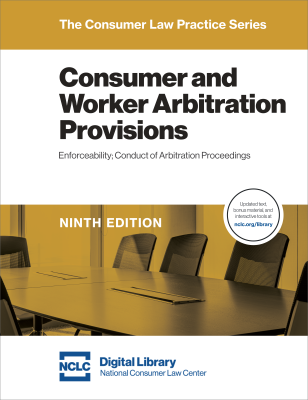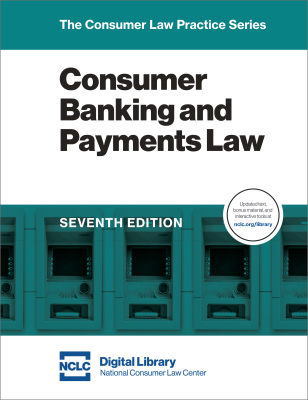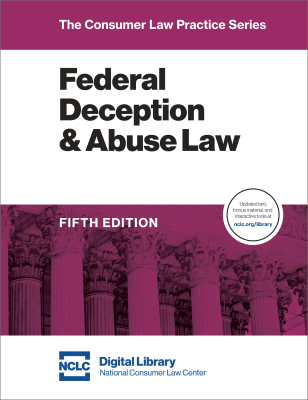The unique nature of electronic contracts and electronic signatures provides grounds to challenge their enforceability, including whether a consumer’s electronic “signature” was logically associated with the terms and conditions buried in digital pages as well as whether it was the consumer who had visited the site or an imposter. Use of electronic contacts during in-person transactions is even more prone to fraud and forgeries.
These issues are significant to not only whether a consumer has validly agreed to a transaction, but also whether the consumer has agreed to the transaction’s terms and conditions, like an arbitration requirement, consent to receive robocalls and texts, and limitations on the consumer’s remedies. This article sets out six keys to challenging terms and conditions found in electronic contracts.
1. Challenges to Electronic Terms’ Consummation Should Never Go to Arbitration
Many consumer contracts contain terms and conditions that require arbitration of any consumer dispute and contain a clause delegating questions of the enforceability of the arbitration requirement to the arbitrator. Courts often enforce such delegation clauses.
This is not the case where the consumer challenges whether the terms and conditions were validly consummated. That is always for the court, irrespective of a delegation clause. See Granite Rock Co. v. Int’l Bhd. of Teamsters, 561 U.S. 287 (2010). See also Coinbase, Inc. v. Suski, 602 U.S. 143 (2024) (court decides which of two contracts apply); NCLC’s Consumer and Worker Arbitration Provisions § 4.2.4 (citing numerous cases holding that courts decide whether an agreement has been validly consummated despite a delegation clause).
To compel arbitration without first determining whether the parties agreed to do so would undermine the bedrock principle that “arbitration is a matter of consent, not coercion.” Stolt-Nielsen S.A. v. AnimalFeeds Int’l Corp., 559 U.S. 662, 681 (2010). If a contract has not been validly formed, the delegation clause (as part of that contract) has not been validly formed. Questions of such contract formation are always for the court. Granite Rock Co., 561 U.S. 287, 296 (2010) (“where the dispute at issue concerns contract formation, the dispute is generally for courts to decide”).
When challenging valid consent to electronic terms and conditions, always affirmatively raise with the court that the delegation clause does not apply in this instance. Failure to address this issue to the court too often results in a court mistakenly sending the question to the arbitrator. Instead, address the delegation clause head-on with the court. For a roadmap of the various ways to attack a delegation clause, even when the challenge is not to the contract’s consummation, see NCLC’s Consumer and Worker Arbitration Provisions § 2.3.
2. A Business May Put in Evidence the Wrong Electronic Contract
Essential to a business’s attempt to enforce a contract term is the production of the full text of the actual contract consented to by the consumer, including the terms and conditions. This burden is on the business. See NCLC’s Collection Actions § 4.5.3.1. In a surprising number of cases, a business will produce the wrong version of the contract, not the one presented to and electronically signed by the consumer.
In the case of terms and conditions found on a website, there will be multiple versions of the terms and conditions as they often change over time. Different terms and conditions for the same seller may even appear simultaneously on the seller’s different websites. The business must present the “transferable record” that the consumer consented to, specifically the “authoritative copy,” of the record signed by the consumer, not an earlier, later, or otherwise different version. See Uniform Electronic Transactions Act § 16.
One consumer tactic to rebut a version of terms and conditions presented to the court is to use the Internet Archive’s “Wayback Machine” to see if the contract the business produced matches the version that the Wayback Machine recorded on the date the consumer is said to have signed the contract. See, e.g., Newell v. LendVia, L.L.C., 2025 WL 2380706 (E.D. Pa. Aug. 15, 2025) (alleging the business produced the wrong version based upon the version produced by the Wayback Machine).
Instructions for use of the “Wayback Machine” are found here, allowing one to find a business’s terms and conditions as of a certain date. If the contract found on the Wayback Machine applicable to the date of signing differs from the contract the business presented, this not only places into question the business’s version of the contract, but also puts in play the credibility of the seller’s witness that introduced the potentially wrong contract.
Of course, even if the business introduces into evidence the correct terms and conditions, sales representatives’ oral statements contradicting those terms are actionable under a state UDAP statute. See NCLC’s Unfair and Deceptive Acts and Practices § 4.2.16. In addition, a sales representative’s misrepresentation of terms may make them unenforceable. See, e.g., NCLC’s Consumer and Worker Arbitration Provisions § 4.3.7.2 (arbitration provision not enforceable if misrepresented). The contract and the disclosures must be provided to the consumer in a format that is capable of retention by the consumer, in the format required, otherwise it is not enforceable against the consumer. See Uniform Electronic Transaction Act § 8.
Similarly, if the business failed to provide disclosures required to be provided to the consumer in a timely way and in compliance with the E-Sign consent requirements (see “5. Electronic Contracts Executed When Parties Are in the Same Physical Space,” infra), the consumer may have a claim for the failure to provide such disclosures in the proper format. See NCLC’s Consumer Banking and Payments Law § 13.4.
3. Where Consumer Never Visited the Site; Forged Electronic Signatures
In enforcing an electronic contract, a business will have to prove it was the consumer who consummated the contract. There will be no paperwork with an ink signature, just an allegation that it was the consumer who completed an electronic form. If the consumer denies visiting the applicable website or signing an electronic device at the point of sale, and presents evidence supporting that denial, the burden of proof generally shifts to the party seeking to prove the contract to show that it was the consumer who assented to the contract. See, e.g., NCLC’s Consumer Banking and Payments Law § 13.6.4.
Sellers may present evidence that the transaction included the entry of the consumer’s address, phone number, email address, and even birth date, credit card number, Social Security number, or IP address. However, much of that information is often available for sale on the dark web, or elsewhere, and should not be considered conclusive. Businesses may also have a recording of a person’s keystrokes on the site, entering the information and clicking on a checkbox. Even that is not necessarily evidence that it was the consumer performing the recorded keystrokes and not someone else.
To overcome evidence the business presents that a specific consumer visited the site, the consumer can present credible evidence to the contrary. A consumer might allege that the consumer was a recent victim of a data breach that included the identifying information used on the site, and that this identifying information was used by an unknown person to also engage in other transactions in the consumer’s name. Courts with conflicting evidence may send the issue to the fact finder at trial. See, e.g., Newell v. LendVia, L.L.C., 2025 WL 2380706 (E.D. Pa. Aug. 15, 2025); Davis v. Clear Health, L.L.C., 2024 WL 4041421, at *8 (N.D. Ohio Sept. 4, 2024).
Another explanation for a website having a consumer’s identifying information is that the consumer had supplied the information to one website, and a marketer used bots and “human click farms” on a lead generator’s website to enter the consumer’s data into a second website that the consumer has never visited. In such a scenario, a website’s owner hires a marketer to drive customers to its website and pays the marketer by the website click.
The marketer has a financial incentive to use bots and “human click farms” to create fictitious traffic to the second site, based upon consumer data it has purchased or otherwise obtained from another website. It manipulates the data to appear as if the consumer visited the second website, and not just the first site. This occurs so frequently that website owners hire experts to detect such fraud. See NCLC’s Federal Deception & Abuse Law § 6.4.5.2.1.
The inadequacy of the business’s security measures, and the permeability of the signing platform can also be raised to challenge the validity of a business’s evidence. See, e.g., Menjivar v. True Bullion L.L.C., 2024 WL 123675, at *9, *12 (Cal. Ct. App. Jan. 11, 2024) (employer could have forged employee’s electronic signature where it had access to employee’s email account, and employee testified that he did not sign the agreement).
Ask if the consumer recalls going to the website in question or had reason to do so—for instance, if the website promotes student loans, was the consumer even looking for such a loan in the first place? Check to see if the consumer’s static IP address on their devices matches the IP address provided by the company. While neither a match nor a mismatch is conclusive, it will help narrow the investigation. Moreover, a website having hundreds or thousands of records associated with the same IP address may indicate that the data associated with that IP address was originated by bots or automated processes. Look at available public databases such as Maxmind GeoIP and IPState for the list of addresses registered with the American Registry for Internet Numbers. An expert also can help identify fraudulent information.
If the seller provides an exact time of day the site was visited, can the consumer show the consumer was otherwise engaged at that time and could not have been on the internet? Was the consumer’s location at that time inconsistent with the claimed IP address?
Similar issues are raised in an electronic point-of-sale transaction in which the parties are in the same physical space. That a sales representative met with the consumer in person and obtained certain information does not mean that it was the consumer who signed an electronic device or clicked on a button—it could just as easily be the sales representative. Look for any evidence that the consumer could not have clicked on the device at the time indicated. Also ask the consumer if it was the seller that created an email address for the consumer—this indicates the amount of control the seller had over the transaction.
For transactions in the consumer’s home, check the IP address used to sign the documents to see if it could have belonged to the consumer or whether it was more likely associated with the seller. For a case where the seller created a false email address for a consumer and the in-home transaction involved an IP address associated with the seller’s internet service, not the consumer’s, see de Moura Castro by Hilario v. Loanpal, L.L.C., 715 F. Supp. 3d 373 (D. Conn. 2024).
4. Was the Consumer’s Mouse Click Logically Associated with the Terms and Conditions?
When a consumer consents to a transaction electronically, such as clicking a “submit” button or a checkbox, or adding an electronic signature, it does not mean that the consumer has also agreed to terms and conditions found by clicking on a hyperlink residing elsewhere on the website or the point-of-sale device. To bind the consumer, the consumer’s action applying the electronic signature must be “attached to or logically associated” with the terms and conditions on the website or device. See E-Sign Act, 15 U.S.C. § 7006(5); NCLC’s Consumer Banking and Payments Law § 13.6.5; NCLC’s Consumer and Worker Arbitration Provisions § 4.3.4. For the electronic click to be considered a binding signature, the consumer must have intended to agree to the terms and conditions.
A hyperlink to terms and conditions must be readily apparent and near to the location where the consumer takes the electronic action. Is the link so small and inconspicuous as not to be noticed? Can the consumer click a button signifying consent to a transaction without even seeing the link to the terms and conditions? Is the language indicating a link to terms and conditions ambiguous or unclear? Is there more than one way to purchase an item and one way does not mention the terms and conditions?
Evaluate the logical association of the electronic action to the terms and conditions by trying to duplicate as much as possible what would be displayed to the consumer on the consumer’s device and software. The association of the signature to the terms must be logical based on what is displayed on the consumer’s device and not some other platform. The critical issue is whether the terms and conditions were sufficiently accessible and clear to the consumer such that the consumer’s click meant to signify an intent to agree to those terms and conditions.
The most extensive case law as to the logical association of an electronic signature to terms and conditions involves the enforceability of an arbitration provision found in the terms and conditions and analyzed at NCLC’s Consumer and Worker Arbitration Provisions § 4.3.4. A leading case is Berman v. Freedom Fin. Network, L.L.C., 30 F.4th 849 (9th Cir. 2022).
5. Electronic Contracts Executed When Parties Are in the Same Physical Space
Door-to-door and other electronic transactions where the parties are in the same physical space are increasing in frequency by using tablets or similar devices to obtain an individual’s electronic consent to a transaction and to the contract’s terms and conditions. Often no paper version of the contract is provided, and the consumer is asked to view the contract and sign it on the seller’s device.
However, for the consumer to have intended an electronic signature to apply to the contract, the consumer needs an opportunity to see the contract before the electronic signature is applied. Such in-person electronic transactions have significant potential for abuse as the salesperson can easily manipulate the electronic process, preventing the consumer from understanding the full implications of the electronic consent or even forging the consumer’s electronic signature.
Sales representatives in full control of their own tablet can scroll through pages at breakneck speed and ask the consumer to click or sign a page even though there is little information on that page except a signature block or checkbox. For example, the Tenth Circuit in Parisi v. Greensky, L.L.C., 2025 WL 1603282 (10th Cir. June 6, 2025), had little problem refusing to enforce an electronic contract executed when the parties were in the same space with the following facts:
The consumer signed a credit application on the salesperson’s iPad. The salesperson then swiped the iPad to show a screen displaying only a checkbox and signature line. By checking the box, the consumer’s original electronic signature was affixed to the new signature line. Without providing any additional explanation, the salesperson presented such a screen approximately twelve times and the consumer checked each, unaware that the consumer was indicating consent to a loan and the loan terms. The seller emailed a copy of the contract that went to a spam folder, and weeks later a paper copy was sent to the consumer. Neither version matched the loan terms that were orally told to the consumer.
If a state home solicitation sales statute requires disclosure of a three-day right to cancel, and the consumer is not provided disclosure of this right at the point-of-sale in a form the consumer can keep, the consumer may have a continuing right to cancel the contract. See NCLC’s Federal Deception and Abuse Law § 2.6.7. This is certainly the case where a seller creates an email address to send the disclosure, and the consumer does not have the capability or understanding to access the email.
In another point-of-sale case, Goudarzi v. J.P. Morgan Chase Bank N.A., 2025 WL 1953121, at *6–7 (W.D. Wash. July 16, 2025), the federal court refused to enforce certain contract terms where the consumer electronically created a bank account merely by selecting a password, with a banking official then completing all the information requested by the online account application. The consumer never saw the link to the bank’s terms and conditions, and the bank could not prove that it had otherwise shown the terms and conditions to the consumer.
There is little to prevent fraud where a sales representative adds an electronic signature or clicks on a checkbox pretending to be the consumer. The sales representative could be doing so after leaving the consumer, or after the consumer had provided certain personal information but not the consumer’s consent to anything. Even if the consumer has used an electronic signature on one version of the contract, the business can then take that signature and replicate it on an entirely different contract it claims to be the operative one.
Businesses that employ electronic signatures should have comprehensive records of the time and IP addresses used when a signature is applied. A recording or other background information should include pages viewed, how long they were on the screen, and the date and time of each action. A pattern of very fast clicking could support an inference that the seller did not to give the give consumer a chance to read anything. Electronic actions taken on a date when the consumer was not even present should indicate forgery.
If federal or state law requires that a sale be accompanied by certain disclosures in “writing,” for the disclosures to be effective if given electronically, the consumer must first have been provided “E-Sign consent” to receive those disclosures in an electronic format. 15 U.S.C. § 7001(c). E-Sign consent requires several disclosures be given to the consumer before the consumer is asked to consent and then the consumer must consent to receive disclosures electronically in “a manner that reasonably demonstrates that the consumer can access information in the electronic form that will be used to provide the information . . . .” See NCLC’s Consumer Banking and Payments Law § 13.4.
The E-Sign consent is not effective if the required disclosures are provided only on the seller’s device prior to consummating the transaction if the seller does not email or otherwise provide the disclosures to the consumer in a format the consumer can actually access, and the consumer accesses them before the consumer signed the contract.
6. Does the Business Enforcing the Terms and Conditions Have Rights Under the Contract?
A party seeking to enforce the contract terms might not be the owner of the website visited by the consumer. Any number of permutations are possible as to the relationship of the website owner to the person seeking to enforce the electronic terms and conditions.
A party not listed in the terms and conditions may not be able to enforce them. The terms and conditions instead may list various categories of parties that can enforce the terms and conditions, such as a named party’s agents, affiliates, or partners. But a party seeking to enforce the terms has the burden of showing that it fits into one of those categories.
A lead generator’s website may attempt to avoid these issues by indicating that the terms and conditions are applicable to “partners” and by only disclosing the names of those entities through a hyperlink listing sometimes thousands of named partners. This can be challenged on the grounds that the consumer’s consent to the contract is not clearly and conspicuously disclosed through such a secondary link. See Gaker v. Citizens Disability, L.L.C., 654 F. Supp. 3d 66, 77 (D. Mass. 2023) (finding hyperlink to list of marketing partners was “a textbook example of a webpage that attempts to hide its consent language from its users”).
The party seeking to enforce the terms and conditions may claim it can do so as a third-party beneficiary or based on equitable estoppel, but those grounds are sharply limited. See the extensive discussion of equitable estoppel and third party beneficiary at NCLC’s Consumer and Worker Arbitration Provisions §§ 5.5.4, 5.5.5.




